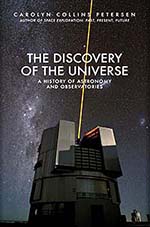The Discovery of the Universe
A History of Astronomy and Observatories
The discovery of the universe is an ongoing project in human history. It began with the first people looking up at the sky and trying to figure out what those objects were that they saw. As humanity's technological prowess advanced, we built observatories to measure and study celestial objects. That's the story that I tell in this new book. There are thousands of observatories around the world, a testament to our curiosity about the cosmos. Yet, it's a real challenge to tell the story of these places in only 110,000 words...or even a half million words. Amberley Books wanted something that would appeal to readers who knew a little about astronomy, or perhaps were just starting to learn about it. So, I set out to give readers a tour of observatory and astronomy history without overloading everyone with a lot of arcane terminology and technical information. It isn't meant to be encyclopedic, but to give readers a good taste of what observatories and the astronomy they enabled is all about.
Why Do It?
I've been asked, "Why do a book about the discovery of the universe? It's all been written about before."
This is true, but the past is prelude to the present and future. You have to cover some amount of history to see what the future of astronomy and observatories can be. The book begins at the first observing sites in prehistory and goes from there. It takes us through several "golden ages" of astronomy, each one marked by technological advances.
For example, before the invention of the telescope, people around the world used other means to measure and study the sky. They built some magnificent facilities, such as Stonehenge, the Jantar Mantar complexes in India, and Tycho Brahe's observatory on the island of Hven.
After the telescope came into use, astronomers spent much time and effort perfecting their mirrors, and eventually building additional instruments (such as spectroscopes) to further the scientific study of astronomy. That golden age of astronomy, spurred by Galileo and others, led to yet another one in the 20th century, when ever-larger telescopes and intricate instruments became the norm. I'd also posit that we're in a fourth golden age, that of space astronomy, where orbiting telescopes extend our gaze out to the limits of the observable universe.
Astronomy for All
Of course, astronomy is not limited to scientists with access to large telescopes. There's a thriving amateur community of observers, some of whom work with professionals to extend our view. The current golden age of astronomy is also blessed with so-called "Citizen Science" initiatives that began back in the 1980s, with ordinary folks contributing their time and efforts (and computers and cameras) to astronomical observations. That story, too, is part of this book.
Beyond Mirrors: Observatories of the New Age
Of course, now that we are in an age of multi-wavelength and multi-messenger astronomy, I also take a look at some rather unusual observatories in this book. Scientists today routinely measure neutrinos and cosmic rays with instruments that look nothing like the mirrored telescopes of old. They also detect gravitational waves, using techniques that would have mystified our earliest astronomical forebears. Those methods and observatories, ranging from IceCUBE in Antarctica to underwater neutrino detectors and space-based gravitational wave detectors still under design, round out this look at observatories.
Looking Ahead
The future of astronomy is heavily dependent on new discoveries made by state-of-the-art detectors. Each new finding sends astronomers looking for the next best technological "thing". Whether they do it with ground-based behemoths coming online in the next decade or so, or space-based arrays, the study of distant stars and galaxies remains a promising one. This book helps readers understand where we're going with those future observatories, giving them a solid grounding of the past and present.



